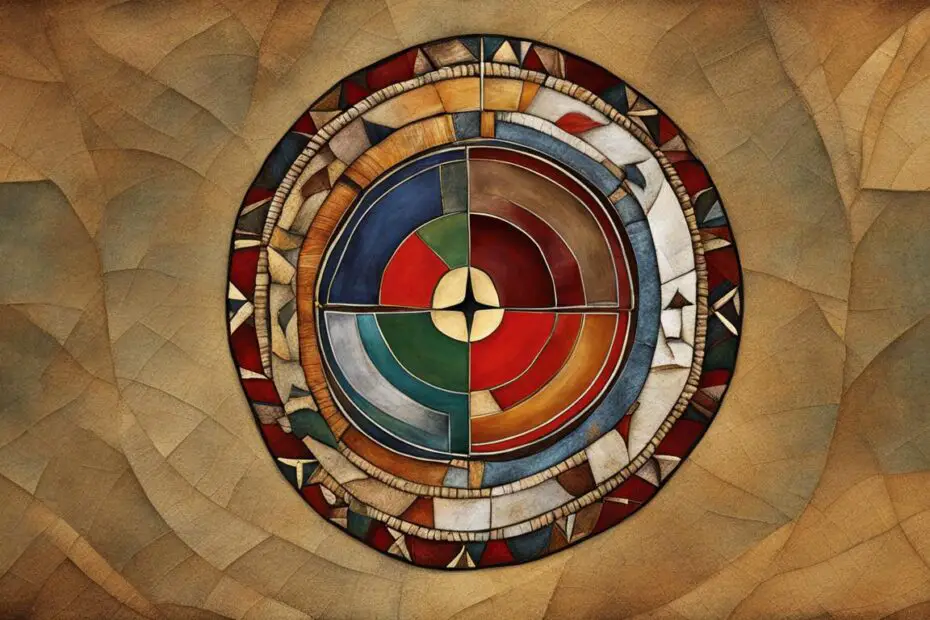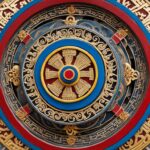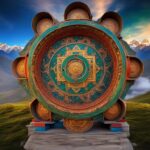The Medicine Wheel is a profound symbol deeply rooted in Native American spirituality and healing practices. It represents a sacred circle that embodies indigenous teachings of balance and harmony, offering a spiritual journey for those who seek it. This ancient symbol is a tool used in traditional medicine and promotes holistic wellness by fostering a connection to the natural world. It also plays a central role in ritual ceremonies, enhancing the spiritual experience.
Key Takeaways:
- The Medicine Wheel is a symbol of Native American spirituality and healing practices.
- It represents a sacred circle and offers a spiritual journey to seekers.
- The Medicine Wheel promotes balance, harmony, and holistic wellness.
- It is used as a tool in traditional medicine and in ritual ceremonies.
- The Medicine Wheel enhances the connection to the natural world and fosters a deeper spiritual understanding.
The Main Prayer Tools of the Medicine Wheel
The Medicine Wheel utilizes various prayer tools to enhance spiritual connection and facilitate healing. These sacred objects can include feathers, crystals, tobacco, herbs, drums, and rattles. Each prayer tool is used in specific rituals and has symbolic significance within Native American culture. These tools help individuals connect to their spirituality, seek guidance, and find balance and harmony within themselves and the world around them.
The feathers used in the Medicine Wheel represent a connection to the spirit world and the ability to soar above earthly concerns. They are often used for smudging, cleansing, and invoking blessings. Crystals, such as quartz or amethyst, are believed to hold powerful energy and are used for energy healing and balancing the chakras. Tobacco and sacred herbs, such as sage or sweetgrass, are offered as prayers and used in ceremonial smoke rituals to communicate with the spiritual realm.
Drums and rattles are integral to the Medicine Wheel as they create a rhythmic sound that aids in meditation and spiritual journeying. The heartbeat-like rhythm of the drum represents the heartbeat of Mother Earth and the rhythm of life. The sound of the drum or rattle can induce a trance-like state and facilitate connection with the spiritual realm. These prayer tools are used with intention and reverence, allowing individuals to enter a state of deep meditation, receive messages, and seek spiritual guidance.
| Prayer Tool | Symbolic Significance | Usage |
|---|---|---|
| Feathers | Connection to the spirit world, ability to soar | Smudging, cleansing, invoking blessings |
| Crystals | Powerful energy, healing, balance | Energy healing, chakra balancing |
| Tobacco and Sacred Herbs | Prayers, communication with the spiritual realm | Ceremonial smoke rituals |
| Drums and Rattles | Rhythm of life, connection to Mother Earth | Meditation, spiritual journeying |
The Main Prayer Tools of the Medicine Wheel
The Medicine Wheel utilizes various prayer tools to enhance spiritual connection and facilitate healing. These sacred objects can include feathers, crystals, tobacco, herbs, drums, and rattles. Each prayer tool is used in specific rituals and has symbolic significance within Native American culture.
Feathers, often from birds such as eagles or owls, are used for smudging, cleansing, and invoking blessings. They represent the ability to soar, to connect with the higher realms, and to receive messages from the spirit world. Crystals, such as quartz or amethyst, are used for energy healing and balancing chakras. They symbolize the earth’s energy and healing properties, amplifying intentions and promoting balance.
Tobacco and sacred herbs, such as sage or sweetgrass, are offered as prayers and used in ceremonial smoke rituals. They signify offering prayers and creating smoke as a means of communication with the spiritual realm. Drums and rattles are played to create a rhythmic sound that aids in meditation and spiritual journeying. They represent the heartbeat of Mother Earth and the rhythm of life.
| Prayer Tool | Symbolic Significance |
|---|---|
| Feathers | Ability to soar, connect with higher realms, and receive messages |
| Crystals | Earth’s energy, healing properties, and amplification of intentions |
| Tobacco and sacred herbs | Offering prayers and communication with the spiritual realm |
| Drums and rattles | Heartbeat of Mother Earth and rhythm of life |
These prayer tools are utilized with intention and reverence to deepen one’s connection to the spiritual realm and promote healing. They play a crucial role in the spiritual practices and healing rituals associated with the Medicine Wheel.
Symbols of the Medicine Wheel’s Prayer Tools
The prayer tools used in the Medicine Wheel carry deep symbolic meaning within Native American spirituality. Each tool represents a connection to the spiritual realm and serves a specific purpose in promoting spiritual connection and healing.
Feathers are an essential prayer tool in the Medicine Wheel, representing the ability to soar and connect with the higher realms. They are seen as a means of receiving messages from the spirit world and invoking blessings. Crystals, another powerful prayer tool, symbolize the earth’s energy and healing properties. They are believed to amplify intentions and promote balance within the individual.
Tobacco and sacred herbs hold great significance in Native American spirituality, signifying the offering of prayers. These substances are used in ceremonial smoke rituals, creating a means of communication with the spiritual realm. The smudging of sacred herbs and the offering of tobacco are acts of reverence and gratitude.
The Symbolism of the Medicine Wheel’s Prayer Tools:
| Prayer Tool | Symbolism |
|---|---|
| Feathers | Ability to connect with higher realms and receive messages from the spirit world. |
| Crystals | Earth’s energy, healing properties, and amplification of intentions. |
| Tobacco and Sacred Herbs | Offering prayers and creating smoke as a means of communication with the spiritual realm. |
In the Medicine Wheel, drums and rattles represent the heartbeat of Mother Earth and the rhythm of life. They are played to create a rhythmic sound that aids in meditation and spiritual journeying. The sound of the drum and rattle helps individuals connect to their inner selves and the world around them.
These prayer tools play a vital role in Native American spirituality, facilitating deep spiritual connection, personal growth, and healing. Their symbolism serves as a reminder of the interconnectedness of all beings and the importance of maintaining balance and harmony in our lives.
Throughout different sects of Native American traditions, variations in the use of prayer tools may occur. Each tribe or community may have its own unique rituals and meanings associated with the Medicine Wheel. It is important to respect and honor these variations, as they reflect the rich cultural diversity and distinct spiritual practices within Native American communities.
Variations Among Medicine Wheel Sects
The Medicine Wheel, a sacred circle of Native American spirituality, holds deep significance in various indigenous cultures. While it serves as a unifying symbol, there are variations in the practice and interpretation of the Medicine Wheel among different sects. Each tribe has its own unique rituals, prayers, and specific meanings associated with the Medicine Wheel. These variations reflect the cultural diversity and distinct spiritual practices within Native American communities.
For example, the Lakota Sioux have a specific Medicine Wheel that represents the four directions and the four stages of life. In contrast, the Ojibwe people incorporate more colors and elements into their Medicine Wheel, representing the interconnectedness of all beings.
It is important to respect and honor the traditions and teachings of each sect when engaging with the Medicine Wheel. By acknowledging and appreciating these variations, we can deepen our understanding of indigenous spirituality and cultural diversity.
| Sect | Unique Practices | Meanings |
|---|---|---|
| Lakota Sioux | Four directions and four stages of life | Connection to the natural world and spiritual growth |
| Ojibwe | Incorporation of colors and elements | Interconnectedness of all beings |
| Navajo | Focus on healing and restoration | Connection to ancestral spirits |
Materials Used for Medicine Wheel Prayer Tools
The prayer tools of the Medicine Wheel are carefully crafted using a variety of sacred materials sourced from nature. These materials play a significant role in enhancing the spiritual connection and symbolism associated with each tool. Here are some common materials used:
Feathers
Feathers are essential prayer tools in the Medicine Wheel. They are often obtained from birds such as eagles, hawks, or owls. Feathers symbolize the ability to soar and connect with the higher realms. They are used in smudging ceremonies, cleansing rituals, and as tools for invoking blessings.
Crystals
Crystals hold a special place in the Medicine Wheel and are believed to carry the earth’s energy and healing properties. They are commonly used for energy healing and balancing chakras. Different crystals are chosen based on their unique vibrations and associations with specific intentions and purposes.
Tobacco and Sacred Herbs
Tobacco and sacred herbs are integral parts of Native American spirituality. They are used for offering prayers and creating smoke as a means of communication with the spiritual realm. These herbs are carefully harvested, prepared, and used with great reverence and intention.
Drums and Rattles
Drums and rattles are important instruments in the Medicine Wheel. They are made from natural materials such as wood and animal hides. Drums produce a rhythmic sound that aids in meditation and spiritual journeying, while rattles create a soothing and calming effect during ceremonies and rituals.
These sacred materials not only add tangible elements to the prayer tools but also deepen the connection to nature and emphasize the importance of honoring and preserving the natural world.
| Prayer Tool | Material |
|---|---|
| Feathers | Obtained from birds such as eagles, hawks, or owls |
| Crystals | Natural crystals with unique vibrations and healing properties |
| Tobacco and Sacred Herbs | Harvested and prepared with reverence and intention |
| Drums and Rattles | Made from natural materials like wood and animal hides |
The Evolution of Medicine Wheel Prayer Tools Over Time
The prayer tools utilized in the Medicine Wheel have evolved over time, reflecting cultural changes and influences from outside traditions. As Native American communities have experienced shifts in availability and access to specific materials, the prayer tools have adapted and transformed. Additionally, the introduction of new materials and influences from different cultures has impacted the creation and use of these tools. Despite these changes, many indigenous communities strive to maintain the traditional practices and honor the ancestral ways of the Medicine Wheel.
The historical evolution of the Medicine Wheel prayer tools showcases the resilience and adaptability of indigenous spiritual practices. In the past, feather fans were primarily made with natural feathers sourced from local birds, such as eagles or hawks. However, due to legal restrictions, feathers from these birds are now more challenging to obtain, leading to the use of alternative feathers or synthetic materials. Similarly, the availability and harvesting of sacred herbs have been influenced by environmental changes and the preservation of certain plant species.
Another significant change in prayer tools is the introduction of new ceremonial items. While traditional drums were often made from animal hides stretched across wooden frames, contemporary drummers now have access to a wider range of materials, including synthetic drumheads and non-traditional drum shapes. This expansion of materials has allowed for innovative variations in sound and design while still honoring the essential role of drums in Medicine Wheel ceremonies and rituals.
Table: Evolution of Medicine Wheel Prayer Tools
| Prayer Tool | Traditional Material | Evolved Material |
|---|---|---|
| Feather Fan | Natural feathers from eagles or hawks | Alternative feathers or synthetic materials |
| Sacred Herbs | Locally sourced herbs | Harvesting from sustainable sources or substitute herbs |
| Drums | Animal hides stretched across wooden frames | Synthetic drumheads or non-traditional drum shapes |
Despite these changes, the core teachings and spiritual significance of the Medicine Wheel remain intact. The evolution of prayer tools is a testament to the resilience and adaptability of indigenous spirituality and its ability to embrace new materials and influences while staying rooted in tradition and ancestral wisdom. By honoring the historical evolution of the Medicine Wheel prayer tools, we can deepen our understanding and appreciation of this ancient symbol and its continued relevance in contemporary spiritual practices.
Unique and Lesser-Known Prayer Tools
While feathers, crystals, tobacco, and drums are well-known prayer tools associated with the Medicine Wheel, there are also lesser-known tools that hold unique significance within specific indigenous traditions. These tools, often passed down through generations, offer additional ways to connect with the spiritual realm and seek balance and healing.
Dreamcatchers
Dreamcatchers, intricately woven with a web pattern, are believed to capture negative dreams and allow only positive ones to pass through. They are hung above beds or in sacred spaces to aid in protecting individuals from nightmares and promoting peaceful sleep. Dreamcatchers are not only beautiful decorations but also powerful symbols of protection and spiritual guidance.
Medicine Bags
Medicine bags, sometimes called “mojo bags,” are small pouches filled with sacred herbs, stones, or personal objects that hold spiritual significance. They are worn or carried by individuals as a way to keep their connection to the spiritual realm close. These bags serve as a reminder of one’s intentions and provide a sense of comfort and protection during spiritual practices and daily life.
Talking Sticks
Talking sticks are ceremonial tools used in group gatherings or council meetings to ensure respectful and balanced communication. The stick is passed from person to person, granting them the right to speak while others listen attentively. This tool encourages active listening, respect, and harmony within the group, promoting a sense of unity and understanding.
Sacred Pipes
Sacred pipes, also known as “chanupa” or “calumets,” are highly revered in Native American spirituality. They are used in ceremonies as a means to connect with the Great Spirit and offer prayers. The smoke from the sacred pipe is believed to carry the prayers to the spirit world, acting as a conduit between the physical and spiritual realms.
These lesser-known prayer tools expand the range of spiritual practices associated with the Medicine Wheel, allowing individuals to explore different avenues for connecting with their spirituality, seeking balance, and finding healing. Each tool holds unique symbolism and offers its own spiritual benefits, adding depth and richness to the profound teachings of the Medicine Wheel.
The Power of the Medicine Wheel in Modern Society
The Medicine Wheel continues to hold power and significance in modern society as a symbol of spiritual practices and holistic wellness. Many individuals, regardless of their cultural background, are drawn to the Medicine Wheel as a tool for self-reflection, personal growth, and seeking balance in their lives. Its universal teachings of interconnectedness and harmony resonate in a society that often feels disconnected and fragmented. The Medicine Wheel offers a path to reconnecting with oneself and the world around them.
In today’s fast-paced and technology-driven world, the Medicine Wheel serves as a reminder to slow down, reconnect with nature, and prioritize our overall well-being. It encourages us to examine and restore the harmony between our physical, emotional, mental, and spiritual aspects. By incorporating the teachings of the Medicine Wheel into our daily lives, we can cultivate a sense of balance, inner peace, and holistic wellness.
Through spiritual practices such as meditation, prayer, and mindfulness, individuals can tap into the wisdom of the Medicine Wheel and experience a deep connection to the natural world. By honoring the four directions represented by the Medicine Wheel – the east, south, west, and north – we align ourselves with the cycles of nature and gain a broader perspective on life.
| Benefits of Incorporating the Medicine Wheel | Examples |
|---|---|
| Enhanced self-awareness and personal growth | Developing a deeper understanding of one’s strengths, weaknesses, and life purpose |
| Improved mental, emotional, and physical well-being | Reduced stress, increased emotional resilience, and enhanced overall health |
| Greater connection to nature and the environment | Developing a sense of reverence for the natural world and a commitment to environmental stewardship |
| Heightened spiritual connection and intuitive guidance | Strengthening the connection to one’s inner wisdom and accessing spiritual guidance in decision-making |
“The Medicine Wheel has the power to guide us back to ourselves, to our roots, and to our connection with nature. It teaches us to live in harmony with ourselves, others, and the world around us.” – Native American Elder
By embracing the wisdom of the Medicine Wheel, individuals can find a sense of purpose, meaning, and fulfillment in their lives. It invites us to shift our focus from external achievements to inner growth and self-discovery. As we integrate the teachings of the Medicine Wheel into our daily lives, we create a ripple effect of positive change not only within ourselves but also in our relationships and communities.
The Medicine Wheel offers a guiding light in the modern world, reminding us of the interconnectedness of all beings and the importance of living in harmony with ourselves and the natural world. It beckons us to embark on a journey of self-reflection, personal transformation, and spiritual connection. Through its timeless teachings, the Medicine Wheel continues to inspire and empower individuals to lead balanced, fulfilling lives.
Embracing the Wisdom of the Medicine Wheel
The Medicine Wheel holds a wealth of spiritual wisdom rooted in Native American teachings. By embracing this ancient symbol, individuals can embark on a transformative journey of personal growth and self-discovery. Through deepening their understanding of the Medicine Wheel and its teachings, seekers can tap into a wellspring of insight and guidance, leading to profound personal transformation.
Native American teachings emphasize the interconnectedness of all beings and the importance of achieving balance and harmony in life. The Medicine Wheel serves as a roadmap for this journey, offering guidance on how to navigate the physical, emotional, mental, and spiritual realms to find alignment and integration. By incorporating the teachings of the Medicine Wheel into daily life, individuals can gain a deeper sense of self-awareness, cultivate inner peace, and forge a meaningful connection with the world around them.
“The Medicine Wheel is a powerful tool for self-reflection, personal growth, and seeking balance in life.”
Engaging with the Medicine Wheel involves seeking guidance from indigenous teachers and elders who hold deep knowledge of its teachings. These wise individuals serve as spiritual guides, offering insights and practices that can support individuals on their journey of transformation. By drawing upon the wisdom of these teachings and integrating them into daily life, individuals can navigate life’s challenges with greater resilience, uncover their innate strengths, and cultivate a sense of purpose and fulfillment.
As individuals embrace the wisdom of the Medicine Wheel, they are able to tap into their own innate power and wisdom, experiencing personal transformation that extends far beyond the boundaries of their own lives. Through a deeper connection to oneself, others, and the natural world, individuals can contribute to the collective healing and well-being of the Earth and all its inhabitants.
In conclusion, the Medicine Wheel offers a profound path to personal transformation and spiritual fulfillment. By embracing its teachings and incorporating them into daily life, individuals can embark on a journey of self-discovery, find balance and harmony, and contribute to the greater good. The wisdom of the Medicine Wheel is a timeless gift that continues to inspire and guide those who seek a deeper understanding of themselves and their place in the world.
Image source: https://seowriting.ai/32_6.png
Finding Balance and Harmony Through the Medicine Wheel
The Medicine Wheel offers a profound framework for finding balance and harmony in life. It serves as a guiding tool for individuals on their spiritual journey of self-discovery and personal growth. By embracing the teachings of the Medicine Wheel, one can embark on a transformative path that leads to a deeper connection with oneself and the world around them.
The main prayer tools of the Medicine Wheel play a crucial role in this journey. These tools are used in various spiritual practices and healing rituals to facilitate a deep spiritual connection and promote balance. Feathers, crystals, tobacco, herbs, drums, and rattles are among the sacred objects utilized in specific rituals, each symbolizing different aspects of Native American spirituality.
Feathers represent the ability to soar and receive messages from the spirit world. Crystals symbolize the earth’s energy and the power of healing. Tobacco and sacred herbs signify prayers and communication with the spiritual realm. Drums and rattles create a rhythmic sound that aids in meditation and spiritual journeying. These prayer tools are used with intention and reverence, helping individuals find alignment and harmony within themselves and the world.
Conclusion
The Medicine Wheel is an ancient symbol that holds profound significance in Native American spirituality and beyond. It serves as a powerful tool for healing, personal growth, and finding balance and harmony in modern society. By embracing the wisdom and teachings of the Medicine Wheel, individuals can embark on a spiritual journey that leads to greater self-awareness, connection with the natural world, and a deep sense of holistic wellness.
The Medicine Wheel’s timeless teachings continue to inspire and guide seekers on their path to personal transformation and spiritual fulfillment. Its ancient symbol represents the interconnectedness of all beings and the importance of maintaining balance in all aspects of life. Whether through ritual ceremonies, prayer tools, or self-reflection, the Medicine Wheel offers a profound connection to Native American spirituality and a pathway to holistic wellness.
As individuals engage with the Medicine Wheel and its prayer tools, they may discover variations among different indigenous sects. Each tribe may have its own unique rituals, prayers, and interpretations of the Medicine Wheel. It is essential to honor and respect the traditions and teachings of each sect, recognizing the cultural diversity and distinct spiritual practices within Native American communities.
The materials used for the prayer tools of the Medicine Wheel are often sourced from nature, emphasizing the connection between humans and the earth. Feathers, crystals, tobacco, herbs, drums, and rattles are carefully chosen and prepared with intention and respect. While the prayer tools and their symbolism may have changed over time due to cultural shifts and influences, many indigenous communities strive to maintain traditional practices and honor the ancestral ways of the Medicine Wheel.
FAQ
What is the Medicine Wheel?
The Medicine Wheel is an ancient symbol that holds deep significance in Native American spirituality and healing practices. It is a sacred circle that represents a spiritual journey and embodies indigenous teachings of balance and harmony.
What are the prayer tools of the Medicine Wheel?
The prayer tools of the Medicine Wheel include feathers, crystals, tobacco, herbs, drums, and rattles. Each of these sacred objects has symbolic significance and is used in specific rituals and ceremonies.
How are the prayer tools used in practice?
The prayer tools of the Medicine Wheel are used in a variety of spiritual practices and healing rituals. Feathers may be used for smudging and invoking blessings, crystals for energy healing, tobacco and herbs for ceremonial smoke rituals, and drums and rattles for meditation and spiritual journeying.
What do the prayer tools symbolize?
Feathers represent the ability to connect with the higher realms, crystals symbolize the earth’s energy and healing properties, tobacco and herbs signify prayers and communication with the spiritual realm, and drums and rattles represent the heartbeat of Mother Earth and the rhythm of life.
Are there variations in the Medicine Wheel among different indigenous cultures?
Yes, there are variations in the practice and interpretation of the Medicine Wheel among different indigenous cultures. Each tribe may have its own unique rituals, prayers, and specific meanings associated with the Medicine Wheel.
What materials are used for the prayer tools?
The materials used for the prayer tools of the Medicine Wheel are often sourced from nature. Feathers are obtained from birds, crystals are mined from the earth, tobacco and sacred herbs are harvested and prepared with intention, and drums and rattles are made from natural materials like wood and animal hides.
How has the Medicine Wheel evolved over time?
The Medicine Wheel has evolved over time due to cultural changes and influences from outside traditions. The use of specific feathers or herbs may differ based on availability, and the introduction of new materials has impacted the creation of prayer tools. However, many indigenous communities strive to maintain traditional practices and honor the ancestral ways of the Medicine Wheel.
Are there other prayer tools associated with the Medicine Wheel?
Yes, in addition to the commonly known prayer tools, there are lesser-known tools associated with the Medicine Wheel, such as sacred stones, dreamcatchers, medicine bags, talking sticks, or sacred pipes. Each tool has its own purpose and functions as a spiritual aid in the quest for balance, healing, and connection to the spiritual realm.
What is the significance of the Medicine Wheel in modern society?
The Medicine Wheel continues to hold power and significance in modern society as a symbol of spiritual practices and holistic wellness. Many individuals, regardless of their cultural background, are drawn to the Medicine Wheel as a tool for self-reflection, personal growth, and seeking balance in their lives.
How can one embrace the wisdom of the Medicine Wheel?
Embracing the wisdom of the Medicine Wheel involves incorporating its teachings into daily life through mindfulness, deepening spiritual practices, and seeking guidance from indigenous teachers and elders. By integrating these teachings, individuals can experience personal transformation and a deeper sense of connection to themselves, others, and the natural world.
How does the Medicine Wheel help in finding balance and harmony?
The Medicine Wheel provides a framework for finding balance and harmony in life by encouraging individuals to explore all aspects of themselves – the physical, emotional, mental, and spiritual – and seek alignment and integration. Through this spiritual journey, individuals can uncover their strengths and weaknesses, cultivate self-awareness, and discover their unique path to balance and harmony.








